Nazis fuck off and die challenge // Ray // they/them (she/her is acceptable but not preferred) // original content tag: original plant // linguist, programmer and aspiring polyglot // university student // open to helping with anything Dutch, just message me or send an ask // duolingo: dutch-polyglot
Don't wanna be here? Send us removal request.
Text
4.1) Nouns and the Copula
Hello again everyone! 👋🏾 Welcome to another post to help you improve your Japanese!
Over the years, I have done a lot of thinking about Japanese and how the language works. When it comes to parts of speech I think that nouns are the most important one in Japanese. In this post let’s look at why they are so important and the power of nouns-copula pairs.
First, here is the vocabulary that will appear in this post:

【The Importance of Japanese Nouns】
We’ve talked about the 3 main sections of Japanese sentences. If you think about 2 out of those 3 (the topic section and the comment section) you may realize that nouns really do heavy lifting when it comes to communicating ideas.
How do we set up the topic section? Well, we take a noun (or a noun phrase) and attach the particle は to it. Now you or your listener / reader will know what the topic of the conversation is (for the time being). Without that noun part, you don’t have any topic.
Moving over to the comment section, we find that nouns are again very important. Much like the topic, the subject is made up of a noun (or noun phrase) and the particle が. Even though there are times when the subject is not stated, it’s always there - and it always involves a noun.
When you want to end the comment section of any given sentence, you can choose to use an adjective form or a verb form. If you don’t use either of those, your only other option is a noun-copula pair. It’s interesting to realize the several ways that nouns are important forming Japanese sentences.
【The Simplest Sentences】
Take a look at the following three Japanese sentences:
寒い! 食べましょう! 先生です!
These three sentences are perfectly understandable in Japanese society - despite being very short! The first sentence is an adjective and the second one is a verb form. The third one is an example of a noun-copula pair, and it shows that if you take a noun and attach a form of the copula to it, you are all set; with the right context, you will have a perfectly understandable sentence.
So let’s finally get to talking about whatever this copula is.
【What is a Copula??】
A copula is a verb that links or ties two things together. Think of it as a bridge that connects a noun with a description. In English our main copula is the verb “be”. Take a look at these two sentences:
I am a teacher. My friends are teachers.
“Am” is linking the subject (I) with the noun phrase “a teacher“. In the same way, “are” is linking the subject “my friends” with the noun “teachers”. “Am” and “are” in these sentences are two different forms of the same copula! In this case our copula is the “to be” verb, and the nuance of that copula is that the two sides are equal.
If we used a different copula, the meaning and / or nuance of the connection might change. If we used “became” for example, the two sides would still be equal BUT the nuance would change. The copula “became” adds the nuance that they were not always equal.

Japanese, on the other hand, only has 1 copula. Its positioning is also completely different. In Japanese, the noun-copula pair will always come at the end of the comment section*. First you set the topic and or the subject, then at the end, you finish with a noun-copula pair. No matter how many phrases you have in the middle, the noun-copula pair will always refer to (and describe) either the topic, the subject or both.

Japanese may only have one copula but there are many versions of this copula that all have their own nuances. In this post we’re going to take a look at 8 versions of the copula and how each of their nuances is slightly (or completely) different.
【The Polite Versions】
The first 3 versions of the copula are です、でした and でしょう. They are used for formal situations. This may be conversations with or writing for people you don’t know well. If you are talking or texting with someone you just met or someone like a co-worker or manager, you are most likely going to be using some of these 3 versions.
です is used when you want to say the [topic / subject] is / are / am + a description.
① トムです。 = is / am Tom.
The meaning will depend on the topic of the conversation. When someone you don’t know asks you what your name is, they will usually ask お名前は何ですか? Because they already set the topic to “your name”, example 1 is the most natural way to answer. there is no need to say 私の名前は first, because this would just be repetitive and unnecessary.
② 生徒でした。 = was a student / were students
でした is just the past tense of です. The nuance is that something used to be something else, but is no longer that description.
The last polite version of the copula we’ll be looking at is でしょう. This version has several nuances.
③ このセーター、【いい色でしょう】。 = this sweater, good color don’t you think? The color of this sweater looks good, right?
In example 3 you can imagine the speaker holding up a sweater that they recently bought and asking if it’s a good color. This version of the copula means that the speaker / writer believes that there is a connection between the topic / subject and the noun, and that he or she wants to confirm that connection. Notice that the Japanese sentence ends in a period, even though we would use a question mark in English.
④ 冗談でしょう! = It’s a joke / You’re joking, right?
Notice that this request for confirmation of a connection can translate to “don’t you think?” or “right?” in English. Unfortunately, there is one more way that でしょう is used.
⑤ 彼は明日は【暇でしょう】。 = as for him, tomorrow will be free = He will (probably) be free tomorrow.
In example 5, the speaker is more sure of the connection between the topic and the noun marked with でしょう. However, in Japanese culture it’s not good to speak in certainties so this version of でしょう can be translated as somewhere between “is / will be” and “probably is / will be”. It will depend on the speaker / writer’s level of confidence and how open they are with the listener / reader.
【The Plain Versions】
The next 3 versions of the copula are だ、だった and だろう.
だ is the plain version of です. Let’s say that you are very popular in your neighborhood in Japan. You walk into an Izakaya where the regular patrons haven’t seen you in a while. When you walk in, they might exclaim:
⑥ [your name] だ! = It’s you!
Whereas です would be too formal between friends, だ carries the nuance of closeness. We’ll talk more about だ a little later.
⑦ 生徒だった。 = was a student
Example 7 is just the plain version way to say example 2. Other than politeness level, だった and でした are the same.
だろう is basically used in the same way as でしょう, except for the politeness level.
⑧ このセーター、いい色だろう。
Example 8 is very similar to example 3. The meaning is exactly the same but with one key difference in nuance: だろう is more often used by men and boys than women and girls! It also comes off as feeling closer to だ sometimes. In written Japanese it carries the nuance of “I think” or “probably”. On the other hand, when spoken the nuance is stronger, more like “is” or “will be”.
【なら or ならば】
The next version of the copula that we’ll look at is なら(ば).
なら is used in conditional sentences. It carries the nuance of “if”.
⑨ 私が【あなたの立場なら】、… = I, your position if… = If I were in your position…
In written Japanese or if you want to make the conditional part sound a bit more formal, use ならば instead of なら. This is not really anything to think about too much though, because the end of the sentence is more important when it comes to politeness level.
Another thing to be mindful of, is that なら carries with it the implication that the listener / reader knows the context of what you are saying. In other words, sentences with なら(ば) usually come towards the middle or the end of conversation and not at the beginning.
【The Null Copula】
The final version of the copula is an interesting one. Let’s say that you and a friend are at a seafood restaurant in Ōsaka. You both are looking at the menu and your friend asks you what you two should order. You say “let’s go with edamame. How about you?” Your friend answers:
⑩ ぼくは、…かき ⬜︎ 。
Do you think your friend should use です or だ? ?
The answer is neither! です is too formal for a meal with a friend. BUT だ is too strong for this situation! Imagine if in English someone responded with IT’S OYSTERS! It would be very strange. In example 10, the most natural copula to use is none at all - or the null copula.
Technically, there does have to be a copula but by only saying the noun you have adjusted your speech to the appropriate amount of politeness, casualness and strength for the situation.
This will take some time to get right but I think that now you will notice that native speakers sometime leave out the copula when they are talking. This is the null copula.
【Conclusion】
So there you have it! All 8 versions of the Japanese copula.

As always I recommend reading native speakers’ Japanese sentences and looking for what you’ve learned from this post. Next try to listen to some natural conversations. Finally try to make your own sentences and see how they feel. Learning this language is a step-by-step process.
As always, feel free to ask me any questions! Thanks so much for reading and see you next time!
Rice & Peace,
– AL (アル)
👋🏾
* It is possible to have a noun-copula pair NOT at the end of the comment section, but somewhere in the middle. In these cases, the noun-copula pair actually marks the end of a clause. More on this in the next post!
144 notes
·
View notes
Text
I've been having way too much with these so I decided to make my own! Trying not to list multiple books from the same series made me realize that a lot of my favorite books are in fact part of a series 😂
6 notes
·
View notes
Text
I'm gonna reblog with some videos of people speaking various American Indian/indigenous American languages, because I think most people don't even know what they sound like. Not to be judgement of that—just, you know, I think people who want to be informed should know what they sound like!
29K notes
·
View notes
Text
[14.04.25] 28/50 days of booklr
I wanted to create a list with my 100 favorites, but I decided to do this one first.
44 notes
·
View notes
Text

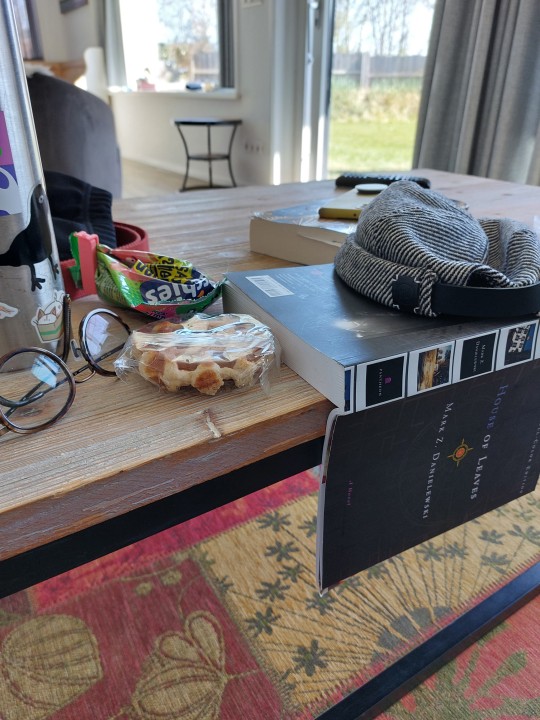

12.04 // It's finally vlacation time! I want to read House of Leaves, see a friend, do lots of bike tours and just become a human again.
7 notes
·
View notes
Text
notes from a diss writing workshop
*As promised, here are some notes/main takeaways i got from the dissertation writing workshop that i attended at my university yesterday! if you have any questions about any of it, i can do my best to answer - i’ve already been through the prospectus-writing process so i’m more personally familiar with that process*
~
why is it (i.e. graduate level argumentation) so hard???
making sure that you’re engaging with previous scholarship; carving out a space for yourself within pre-existing scholarship
committee is pulling you in different directions
trying to organize large amounts of information in a coherent and effective way
the dissertation as argument: types
exploratory arguments: doesn’t bother making pronounced claims, only suggesting possibilities; the “maybe, i don’t know” approach; this is generally what most people do at the beginning of the process of writing the dissertation or at the beginning of their graduate career; it is still a generative approach even if it doesn’t “pan out” (these are usually your seminar papers - because they are so exploratory (i.e. a process of familiarization), we often write them and then forget about them)
additive arguments: takes a corpus or method (or combination of the two) and pushes it further; what’s being generated is a new focal object or a deeper interpretation of a new focal object; this is what the majority of graduate-level writing is; if it doesn’t pan out it’s because something has been misapplied
elaborative arguments: modifying the thing you’re applying by adding not new material, but a new critical apparatus; bringing things together that were previously unrelated; main advantage is that if it works, you’re generating a novel approach and leaving behind a model that can be used by others (can be your conference papers - in writing such a paper, you have to bring something other than your interest to the table; think: in what way might this be interesting to someone other than me?)
corrective arguments: you think someone has done something wrong and you have identified the problem; you need to convince people why it’s wrong and need to provide a solution; high risk (you better be right), high reward (attention-getting) (also often conference papers; can also be journal articles - be aware that writing for a journal is a different animal because the lack of face-to-face interaction means that everything relies on the writing itself)
transformative arguments: transforming a topic so that no one can think about it in the same way ever again; if you can do this then “you’ve won the game of scholarship”
main takeaways:
most students are uncomfortable with elaborative arguments because we’re too focused on content, on telling the reader what we know about a specific topic - we need to take a step back and think about whether you’ve created something that someone can apply to something else entirely (usually you have, but can’t readily identify it)
don’t resist the possibility that you are capable of producing transformative arguments! there’s no guarantee that it will happen, but it also isn’t unlikely to happen; try considering what your conclusions might mean more broadly for your field of study
literature reviews + prospectus
function of a lit review = providing background and summarizing previous literature; often narrativized and related to your argument
people often reproduce in narrative form their own reading process, which seems intuitively sensible, but almost never works to your advantage argumentatively; if you do this, your narrative will ultimately appear convoluted and hard to follow
optimal form of a lit review: make a map for your reader so they don’t get lost; think about where you want to position your reader by the end of the lit review, and think about the path you would have taken to get to that point; think about where your reader would have to begin in order to get where you want them to go
warning: committees are most anxious about a sense of fear - if they feel like you don’t know what you’re doing or where you’re going with your argument, they will intervene and try to help by filling that vacuum with their own expertise which will lead to them “pulling you in different directions”
the lit review is the most underutilized tool for showing your committee that you’re in control of your material; by doing all of the argumentative work in the lit review, you ease pressure off of the prospectus, which should focus on justifying why your work is worth doing
knowing why you’re doing what you’re doing the way that you’re doing it = argumentative authority
dissertation writing tips (aka how to juggle a ton of information)
decide which chapter(s) need to serve an additive function, rather than thinking that the chapter should serve as a representative, microcosmic version of the entire argumentative superstructure; chapter only plays a role in the overall argument
how to make your novel data do more work for you - either you can use scaffolding method, which provides structure to guide the reader where you want them to go - OR - you can simply ask the reader a question and answer it for them; if you can’t formulate and answer a question, how can you expect a reader to do it?
boil your work down into a set of questions rather than a set of claims; we as graduate students are driven by questions but we rarely verbalize them!
if you have all the pieces but don’t know what the overall takeaway of your work is yet - make a list of exclusions, or things that you could do with your data/ argument, but that you don’t want to do - what you’re actually trying to achieve may snap into focus as a result of this exercise
597 notes
·
View notes
Text
This didn't even show up in my notifs, maybe your blog is becoming a ghost?😭
its so validating to recognise almost all the names in the bibliography in a book about your research topic. like yes i did aaallllll those readings!! i know these people and i know what they argue! 10/10
18 notes
·
View notes
Text
As someone in a tiny subfield I'm more shocked if I don't recognize at least 80% of the names lmao. Like anyone I don't know is either someone from a different field or left academia after writing only one or two articles lmao
its so validating to recognise almost all the names in the bibliography in a book about your research topic. like yes i did aaallllll those readings!! i know these people and i know what they argue! 10/10
#just my two cents#it does leave me wondering whenever I don't know someone though#who are you and what are you doing in this bibliography 👀#also I'm rbing bc your replies are broken and I couldn't send an ask:(#@ your blog: get well soon ig
18 notes
·
View notes
Text
sign language & linguistics resource!
linguist Adam Schembri has been updating his amazing resource, What All Linguists Should Know (about sign languages). It's a really fantastic repository of info, including some really great basics that are great for students and non-linguists as well. Please share widely! I'll also copy a few links from his page, just as highlights:
What is sign language? (Schembri, 2013) https://theconversation.com/explainer-what-is-sign-language-21453
How many sign languages are there? (Glottolog) https://glottolog.org/resource/languoid/id/sign1238 (short answer: at least 220)
How are sign languages acquired? (Lillo-Martin & Henner, 2021) https://www.annualreviews.org/doi/abs/10.1146/annurev-linguistics-043020-092357
I recommend that anyone interested in or studying linguistics at any level (from hobbyist to professional!) ask themselves (and colleagues, instructors, students, etc), frequently: wait - is that true about languages in general, or just spoken languages? Have we done any research about how this works in other modalities? Keep asking the question!
858 notes
·
View notes
Text
Are you 18-35 years old and an activist or academic from a minoritized or minority language? This might interest you!
(And even if you don't meet the criteria but are interested in participating in another way, the organizers still encourage you to write to them!)

Website link:
257 notes
·
View notes
Text
The problem here isn’t that large language models hallucinate, lie, or misrepresent the world in some way. It’s that they are not designed to represent the world at all; instead, they are designed to convey convincing lines of text. So when they are provided with a database of some sort, they use this, in one way or another, to make their responses more convincing. But they are not in any real way attempting to convey or transmit the information in the database. As Chirag Shah and Emily Bender put it: “Nothing in the design of language models (whose training task is to predict words given context) is actually designed to handle arithmetic, temporal reasoning, etc. To the extent that they sometimes get the right answer to such questions is only because they happened to synthesize relevant strings out of what was in their training data. No reasoning is involved […] Similarly, language models are prone to making stuff up […] because they are not designed to express some underlying set of information in natural language; they are only manipulating the form of language” (Shah & Bender, 2022). These models aren’t designed to transmit information, so we shouldn’t be too surprised when their assertions turn out to be false.
ChatGPT is bullshit
7K notes
·
View notes
Text
Tamil Linguistics thread (bc nobody cares but me)
but really, if you are interested in linguistics at all, give this post a read, because this shit really blew my mind ...
have been reading the following paper: https://ccat.sas.upenn.edu/~haroldfs/public/h_sch_9a.pdf
"The Tamil Case System" (2003) written by Harold F. Schiffman, Professor Emeritus of Dravidian Linguistics and Culture, University of Pennsylvania
Tamil is one of the oldest continuously-spoken languages in the world, dating back to at least 500 BCE, with nearly 80 million native speakers in South India and elsewhere, and possessed of several interesting characteristics:
a non-Indo-European language family (the Dravidian languages, which include other languages in South India - Malayalam being the most closely related major language - and one in Pakistan)
through the above, speculative ties to the Indus Valley Civilization, one of the first major human civilizations (you can read more about that here)
an agglutinative language, similar to German and others (so while German has Unabhängigkeitserklärungen, and Finnish has istahtaisinkohankaan, in Tamil you can say pōkamuṭiyātavarkaḷukkāka - "for the sake of those who cannot go")
an exclusively head-final language, like Japanese - the main element of a sentence always coming at the end.
a high degree of diglossia between its spoken variant (ST) and formal/literary variant (LT)
cool retroflex consonants (including the retroflex plosives ʈ and ɖ) and a variety of liquid consonants (three L's, two R's)
and a complex case system, similar to Latin, Finnish, or Russian. German has 4 cases, Russian has at least 6, Latin has 6-7, Finnish has 15, and Tamil has... well, that's the focus of Dr. Schiffman's paper.
per most scholars, Tamil has 7-8 cases - coincidentally the same number as Sanskrit. The French wikipedia page for "Tamoul" has 7:
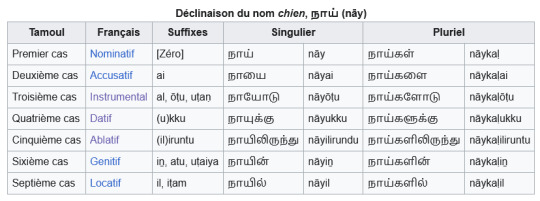
Dr. Schiffman quotes another scholar (Arden 1942) giving 8 cases for modern LT, as in common in "native and missionary grammars", i.e. those written by native Tamil speakers or Christian missionaries. It's the list from above, plus the Vocative case (which is used to address people, think of the KJV Bible's O ye of little faith! for an English vocative)
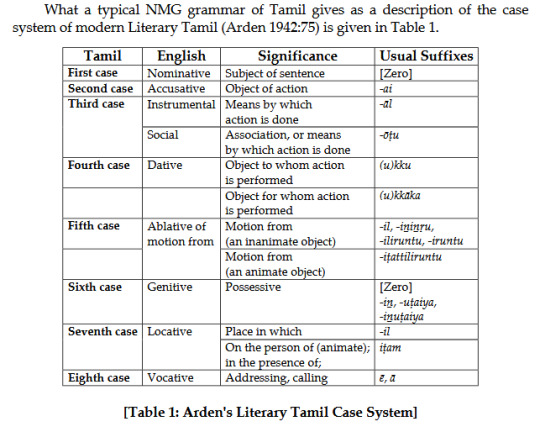
... but hold on, the English wiki for "Tamil grammar" has 10 cases:
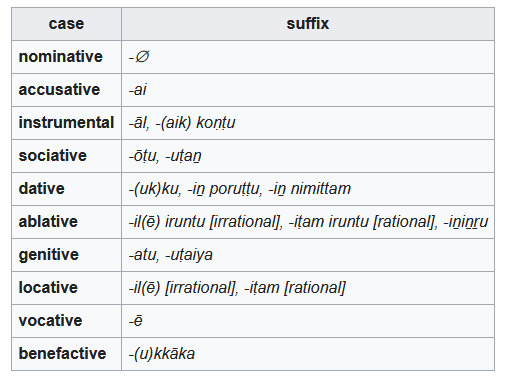
OK, so each page adds a few more. But hold on, why are there multiple suffix entries for each case? Why would you use -otu vs. -utan, or -il vs -ininru vs -ilirintu? How many cases are there actually?
Dr. Schiffman explains why it isn't that easy:
The problem with such a rigid classification is that it fails in a number of important ways ... it is neither an accurate description of the number and shape of the morphemes involved in the system, nor of the syntactic behavior of those morphemes ... It is based on an assumption that there is a clear and unerring way to distinguish between case and postpositional morphemes in the language, when in fact there is no clear distinction.
In other words, Tamil being an agglutinative language, you can stick a bunch of different sounds onto the end of a word, each shifting the meaning, and there is no clear way to call some of those sounds "cases" and other sounds "postpositions".
Schiffman asserts that this system of 7-8 cases was originally developed for Sanskrit (the literary language of North Indian civilizations, of similar antiquity to Tamil, and the liturgical language of Vedic Hinduism) but then tacked onto Tamil post-facto, despite the languages being from completely different families with different grammars.

Schiffman goes through a variety of examples of the incoherence of this model, one of my favorites quoted from Arden 1942 again:

There is no rule as to which ending should be used ... Westerners are apt to use the wrong one. There are no rules but you can still break the rules. Make it make sense!!
Instead of sticking to this system of 7-8 cases which fails the slightest scrutiny, Dr. Schiffman instead proposes that we throw out the whole system and consider every single postposition in the language as a potential case ending:
Having made the claim that there is no clear cut distinction between case and postpositions in Tamil except for the criterion of bound vs. unbound morphology, we are forced to examine all the postpositions as possible candidates for membership in the system. Actually this is probably going too far in the other direction ... since then almost any verb in the language can be advanced to candidacy as a postposition. [!!]
What Schiffman does next is really cool, from a language nerd point of view. He sorts through the various postpositions of the language, and for each area of divergence, uses his understanding of LT and ST to attempt to describe what shades of meaning are being connoted by each suffix. I wouldn't blame you for skipping through this but it is pretty interesting to see him try to figure out the rules behind something that (eg. per Arden 1942) has "no rule".


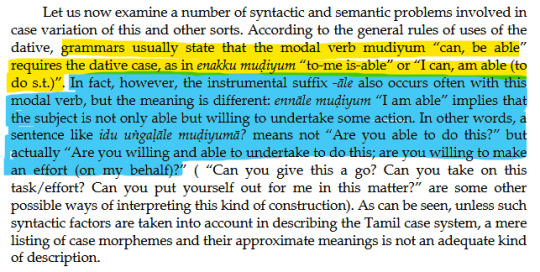
On the "extended dative", which connotates something like "on the behalf of" or "for the sake of":
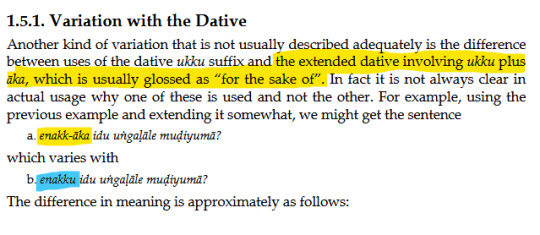

I especially find his analysis of the suffix -kitte fascinating, because Schiffman uncovers a potential case ending in Spoken Tamil that connotes something about the directness or indirectness of an action, separate from the politeness with which the person is speaking to their interlocutor.

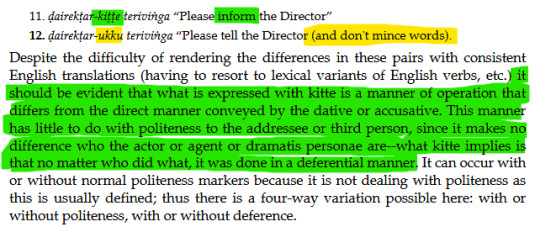
Not to blather on but here's a direct comparison with Finnish, which as stated earlier has 15 cases and not the 7-8 commonly stated of Tamil:
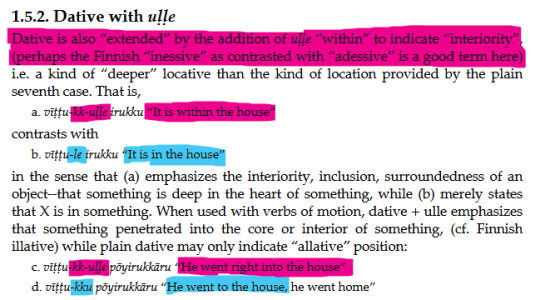
What Schiffman seems to have discovered is that ST, and LT too for that matter, has used existing case endings and in some cases seemingly invented new ones to connote shades of meaning that are lost by the conventional scholar's understanding of Tamil cases. And rather than land on a specific number of cases, he instead says the following, which I find a fascinating concept:
The Tamil Case System is a kind of continuum or polarity, with the “true” case-like morphemes found at one end of the continuum, with less case-like but still bound morphemes next, followed by the commonly recognized postpositions, then finally nominal and verbal expressions that are synonymous with postpositions but not usually recognized as such at the other extreme. This results in a kind of “dendritic” system, with most, but not all, 8 of the basic case nodes capable of being extended in various directions, sometimes overlapping with others, to produce a thicket of branches. The overlap, of course, results from the fact that some postpositions can occur after more than one case, usually with a slight difference in meaning, so that an either-or taxonomy simply does not capture the whole picture.
How many cases does Tamil have? As many as its speakers want, I guess.
175 notes
·
View notes
Text
I finished watching Crá yesterday and now I need to try to persuade as much of tumblr as possible to watch it too.
It's an Irish-language murder mystery TV series set in Donegal, though it's subtitled in English, so you don't need Irish to follow it. It's not a cheerful series - Crá translates to torment - and nearly every single character is in some way corrupt, compromised or morally grey. But it's extremely well-produced, it's gripping, it has an utterly stunning soundtrack (by a Breton composer!) and it's visually gorgeous:



This is the first ever Irish-language TV show to get a primetime slot in Northern Ireland. And I would utterly love for the BBC to invest in more of this kind of thing (it's a BBC/TG4 coproduction). So if this sounds like something you'd be interested in, please help make it a success!
1K notes
·
View notes
Text



20.11 // I took exactly 2 pictures in Amsterdam but in my defense I was busy having a great time!
I went to see Hannah Gadsby live and in color with @dutch-polyglot which was just as amazing and wonderful and brilliant as we could've wished it to be!!! They're an amazing comedian and even better at structuring their set for maximum impact. Woof indeed! I still don't know whats up with whales but maybe this is one of life's big questions we'll never get closure on. I also bought two books I have been eyeing for some time because is it really a trip if you don't buy a book somewhere else?
I should definitely be writing my term paper instead of scrolling on tumblr though....someone save me from my impending deadlines... the adhd displacement activity for "term paper writing" is going strong, I started doing a task I'm procrastinating since February.
background music to drown out the train: Like the moon - GAHO
27 notes
·
View notes
Text

book from the sky (tianshu) xu bing, 1989-91
I was so excited to see a copy of this in real life bc it's something I studied in art history. this is a book that was typeset and printed by hand using wooden blocks but every one of the characters was invented for the sake of the piece and does not correspond to any word in the Chinese language
57K notes
·
View notes
Note

thoughts? (also, i love your blog! i followed you a little while ago and when i had to download praat for my first ever linguistics class this fall i was very excited to see the beautiful logo in the wild)
BRAAT?!
#reading this as /bra:t/ which is so cursed#I wish the creators would understand this joke jagdkshdjsb#linguistics#fun#praat
436 notes
·
View notes
Note
hii! current linguistic student here! do you have a suggestion on how to write IPA symbols? i usually (and stupidly) copy and paste from the IPA chart, but it takes way to long 😩
im not very practical with computers and softwares and stuff like that. help is needed
very nice and cool blog btw! <3
there are a number of downloadable IPA keyboards for different operating systems - unfortunately i got mine like a decade ago and can't remember its name now.
104 notes
·
View notes